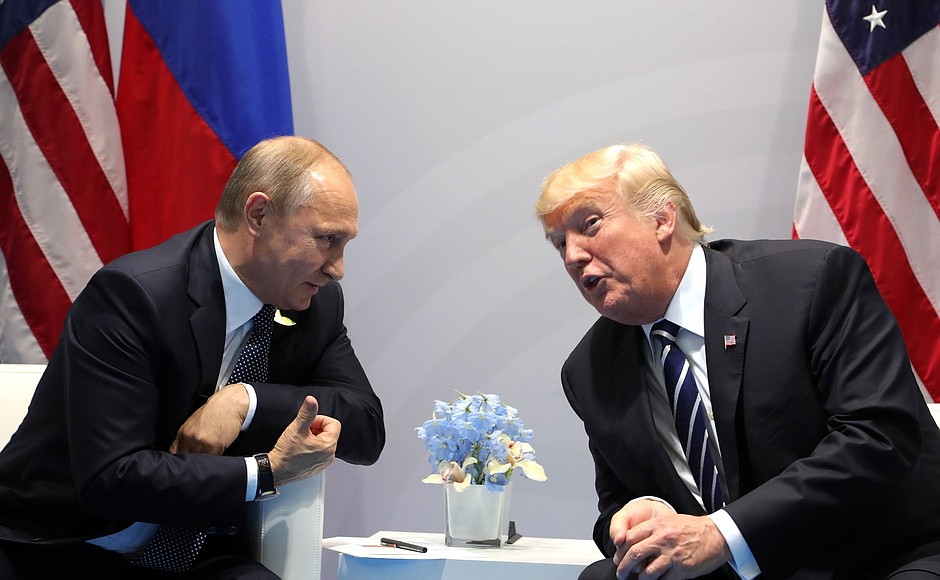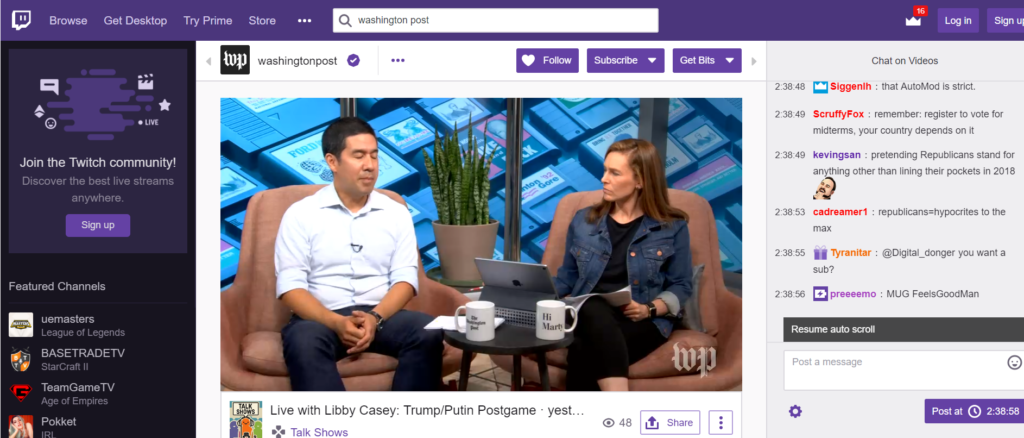
Now, if you’re thinking that based on this post’s title and the above photo, you know where I’m headed, think again.
This post is not about Donald Trump, Vladimir Putin, Helsinki, the Mueller probe, or Stormy Daniels.
It is about how great brands can make the most out of new platforms to expand the tent and grow their audiences. Too often, broadcast radio leadership has viewed new outlets and technologies as “the enemy.” But as we’ve learned with mobile, podcasts, and now smart speakers, savvy brands can harness the power of new platforms to their benefit.
But it requires innovation, imagination, and investment to truly reap the rewards that new platforms can provide. Last winter, we wrote a post about just such an outlet – Twitch.TV.
You may have never heard of Twitch, but millions of web users around the world – especially gamers – most certainly have. According to June data from the Similar Web, Twtich.TV was the 56th most visited website on the planet (48th in the U.S.), racking up nearly 900 million views. And it’s the #1 video gaming site – period.
So, what does this have to do with radio?
While most of the action on Twitch.TV is “spectators” watching the pros play video games (seriously), our post talked about how Bubba the Love Sponge had successfully made the switch to Twitch, racking up impressive data for subscribership, revenue, and fan engagement. At that time, we speculated that other big radio names might find their way to the video streaming platform where fans can engage with their heroes – gamers or disc jockeys.
But earlier this week, something happened on Twitch.TV that suggests this incredible platform can go beyond watching teens play World of Warcraft or Bubba shopping at Publix.
The Washington Post launched its own Twitch.TV channel, marking the first time a traditional media outlet has developed content just for this platform. According to a great commentary by Melynda Fuller, editor of Publishers Daily at Media Post, WaPo has developed programming and is using dedicated hosts on Twitch.
This includes the Post’s political reporter, Dave Weigel, the new hots of “Playing Games With Politicians,” as well as WaPo journalist, Libby Casey (pictured below), who anchored a live Twitch.TV broadcast around the Trump/Putin press conference in Helsinki on Monday.

For Bubba, it’s about his Super P1s.
For the Washington Post, it’s about reaching new users and extending its brand on a completely different platform. That should get the attention of radio executives and their digital teams.
Oh, I neglected to mention Twitch.TV’s owners – it’s Amazon who bought the site back in 2011. Amazon also owns the WaPo, but don’t think for a moment the decision to launch a Twitch channel was just about intra-company cooperation. These two disparate media brands have a lot to offer each other.
Rather than looking at Twitch and other new media outlsets as predatory channels designed to suck away younger consumers, the platform just might end up being the gateway to audience expansion – especially for robust radio station and personality brands.
Melynda’s take: “Brand trumps platform” goes to the heart of how radio should consider how new outlets have the potential to grow audience and expand readership.
While Bubba is making smart use of all the built-in capitalist advantages of Twitch, WaPo is taking a different approach. They’re using it to expand their base to a younger audience trying to figure out what going on out there. It’s about exposure, and attracting younger demos – without any risk to its core subscribership. It’s safe to assume there aren’t a whole of lot of AARP members using the Twitch.TV platform.
Most long-time radio operators built their empires and station brands without a lot of help from others. It required research, investment, personnel, talent, and marketing to launch a sustainably successful station.
But with the web, these new and innovative platforms provide gateways to emerging and hard-to-reach audience previously unavailable to traditional media brands. And by the way, many of them (like Twitch) come with added revenue when executed properly.
For years now, investors have followed Warren Buffett, now worth an estimated $83 billion – and for good reason. His Berkshire Hathaway companies have almost all been massively profitable.
Yesterday, Amazon’s Jeff Bezos became the richest person in modern history at $150 billion – close to double the “Oracle of Omaha’s” net worth. His media holdings and strategic positioning break a lot of rules – and that’s a key reason to pay close attention.
Twitch, and you might miss the next big thing.
I’ll be at Conclave this week on two panels – one about smart speakers with WRIF’s Mark Pennington, iHeart’s Chris Williams, and Hubbard’s Jeremy Sinon. The second, co-presented with my brother Paul, will take you to the floor of CES in Las Vegas, exploring the new innovations in gadgetry and technology that wil impact the radio industry. Hope to see you in Minny.
- Traveling At The Speed of CES - January 10, 2025
- The One Thing Missing At CES? - January 9, 2025
- AI Your Commercials - January 8, 2025




Leave a Reply